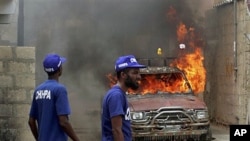Pakistani intelligence officials say a U.S. drone strike has killed four militants in a northwestern tribal region near the Afghan border, marking the second such missile attack in two days.
The officials said Tuesday the U.S. drone fired missiles at the militants' vehicle near Miran Shah, the main town in Pakistan's North Waziristan tribal area. A day earlier, Pakistani security sources said a U.S. drone strike killed four other militants in a vehicle near South Waziristan's main town of Wana. The two largely lawless Pakistani tribal regions are home to Taliban and al-Qaida-linked militants who also operate across the border in Afghanistan.
|
The unrest in Karachi and the murder of journalist Saleem Shehzad, whose body was found dumped in a canal in late May, has editors and reporters in Pakistan thinking hard about how to protect themselves in a country that human rights groups say is the most dangerous in the world for journalists. Bob Deitz is Asia Program Coordinator for the New York-based Committee to Protect Journalists. Deitz told VOA’s Catherine Maddux that Pakistani journalists are taking matters of security into their own hands, and with good reason. A recent post on his blog includes guidelines for Pakistani journalists on how to report in hostile environments. It was written by Zaffar Abbas, an editor at Pakistan English-language daily newspaper Dawn.
To read the entire list, visit the Committee to Protect Journalists. |
U.S. officials have never publicly acknowledged the use of drone strikes against insurgent targets inside Pakistan, but privately have confirmed their existence to various news outlets. Pakistanis often complain that such attacks violate their nation's sovereignty.
The latest drone strike coincided with a visit to Islamabad by the U.S. special envoy for Afghanistan and Pakistan, Marc Grossman. He was due to hold talks with his Pakistani and Afghan counterparts on Tuesday, to coordinate efforts to combat long-running Islamist insurgencies in both nations.
Pakistani officials say suspected militants detonated a roadside bomb near a vehicle carrying Pakistani soldiers in South Waziristan on Tuesday, killing two of them. The attack happened as the troops were patrolling near the town of Ladha.
Meanwhile, a wave of violence in the Pakistani port of Karachi has killed at least 31 people since Monday and prompted the country's interior minister to say the government will take "every possible action to restore peace."
Authorities say 11 people were shot dead in Karachi on Tuesday, while at least 20 were killed the day before. Karachi has a long history of ethnic, sectarian and political violence by armed gangs suspected of links to Pakistan's main political parties. Officials say the violence killed more than 200 people in the city last month.
Pakistani Interior Minister Rehman Malik said Tuesday the government has had enough of the killings and will take stern action to stop them. Pakistani authorities boosted deployments of security forces in Karachi last month, but the violence continued.
Some information for this report was provided by AP, AFP and Reuters.











